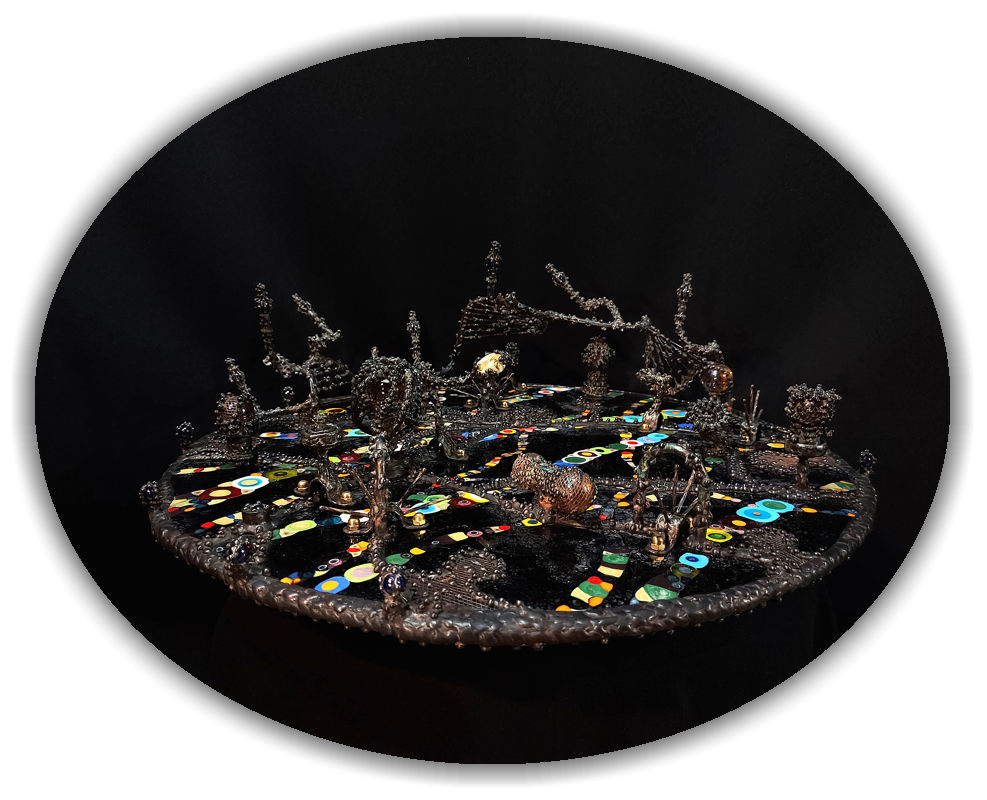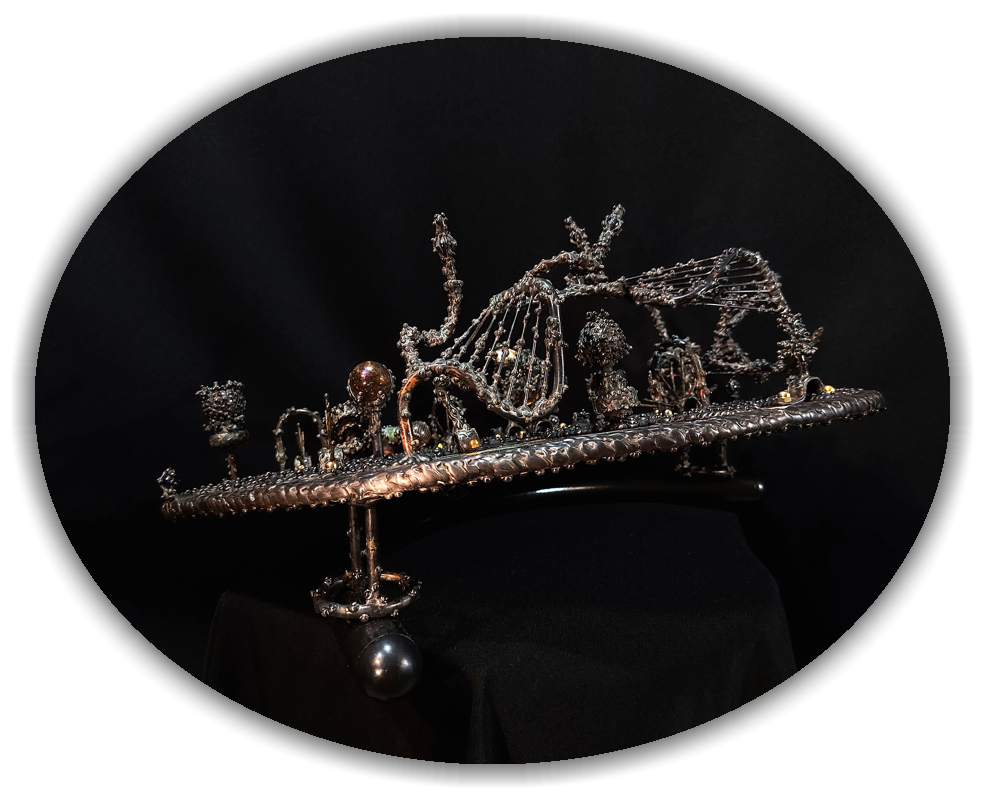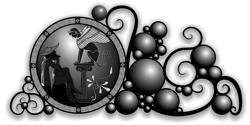| +1-514-400-5214 catalindomniteanu@outlook.com Montreal, QC, Canada | Home | About | Articles | Classes |
Baryonic
56 cm W x 56 cm D x 28 cm H / 9 kg (22" W x 22" D x 11" H / 20 lbs)


Baryonic is made in collaboration with my good friend and beautiful artist Irina Laird, from Calgary, Alberta, who conceived and made the
glass-fusing part.
I kept the work in my studio for several years, revisiting it from time to time without being able to recognize what larger scheme it was part of.
I started out thinking of extrapolating the idea embedded in it, as I often do.
Then I started noticing that the work had a firm, round personality.
Its concept suggests something of organic nature, a microscopic image perhaps. So, instead of incorporating it in a larger vertical panel, I gave
it a role that I thought it wonderfully fits Irina’s original vision. Thus it became the base of our joint creation. The concept of a microscopic
image is what guided me to what if finally became.
Here is now, my part of the fable.
In quantum mechanics, the term “baryonic matter” refers to the familiar material in the Universe.
It’s the stuff that makes the atoms of my fingernails, the yoke of an egg, the mantle of the Earth, the Sun, the nebulas, and all that it is
generally detectable in one way or another. This “ordinary matter”, which once we thought it to be the sole constituent of the Universe, in
fact it only counts for 5% of it. The rest is dark matter, dark energy, and gravitational energy. Scientists were baffled when they discovered
that all this sums up to a zero-energy Universe. No one is sure what that means, but it looks like one doesn’t need energy to make an universe.
How peculiar! Then people realized that this finding brings back into discussion an 18th century thought formulated by polymath GW Leibniz, which demanded an
explanation for why there is something rather than nothing in the Universe. Why there is anything at all? What caused it? Back in time, on the
same topic Aristotle thought that everything has a cause, and that an infinite regress of causation leads to something of an “uncaused cause”.
The question “why” stays forever with us, and not only in our culture, but in the kitchen, when the inquisitive child asks his/her parents
“why” after “why” until they get tired and quit the game. As for the answer, some people say “God”, others “Big Bang”, while others say
“there is no ‘why’; what is it just is”.
Whoever is right (not that we may ever know necessarily) my artistic endeavour calls me to stop and contemplate the grandeur of this
ultimate question about the Universe.
This work goes ambitiously to the outermost limits of our knowledge, in the subatomic world, where the nature’s smallest known components
live. Below that level, the rules are out of reach to our otherwise admirable scientific and philosophic exercise. That is where the sheer
artistic liberty begins.
This work of mine represents an imaginary landscape of smaller, even more fundamental ingredients of nature. What one sees at its
surface is a dynamic peisage of somewhat complex structures. But to make it this way I went against my strong instincts developed from what
physics says about that realm, namely that the complexity goes down with size.
I’ll try to explain.
In ancient Greece, the atomists believed that everything that exists in nature can be fragmented down and, regardless of its tremendous
diversity, reduced in variety to a single fundamental unit they called “atom” - which means “indivisible” (it also means “discrete”, but
that’s another story). They weren’t entirely correct, but they were on the right track. Later on we developed microscopes, and sensors, and
theoretical models, and we’ve learned that the building blocks of all that nature produces can be written down in a small table of elements,
namely the Periodic Table of Mendeleev. Millions of species of life forms turns out to be made out of just 118 distinct atoms (not exactly
the atomists atoms). The modern physics went even deeper and learned that all the chemical elements are themselves made out of a bunch of
sub-atomic particles like neutrons, protons, and electrons, which are made out of smaller parts which can be organized in a table with only
16 elements, called the Standard Model of Subatomic Particles. That’s as far as it goes. The theoretical and the practical instruments that
investigate and probe this model are the pinnacle of the human ingenuity.
But why should I stop there? Is that the final chapter, or is there another substrate of reality awaiting for us to discover, I wonder.
In my investigation of quantum mechanics, the more I learn about its mind bending ideas, the more excited I get. Quantum tunneling,
particle-wave duality, superposition, entanglement, etc. - they are all counterintuitive phenomena to our everyday world; yet, I’m filled
with joy absorbing new ways of seeing how the world works. Among them, one gives me a hint for why we may have reached the bottom.
It is the “observer’s problem”, which takes aim at the fact that the level of energy required to make an observation is comparable to the
energy level of the observed entity. The very act of observation influences the observee. The spectator is no longer away and apart from the
stage, it becomes an actor on that very stage.
I’m strongly tempted to infer that that might just be the bottom of reality. Except that the consistency of the particles like fermions
and bosons must come from somewhere. I’d like to think that it comes from properties. Or maybe beyond that level there is the least one more
layer of particles to reveal. However, if variety went down with every step in size, then I shouldn’t be surprised to find out that the last
one has a variety of, say, three different elements, (there is no variety in one, I feel I should stick with more than one). But can such
small variation of elements generate the fabulous complexity of life? I hear it’s possible. A mathematical theory called “The Game of Life”,
put forward by the British mathematician J H Conway, shows that high level of complexity may indeed arise from small sets of rules. Great!
I’m fully compelled to accept that a narrow variety of fundamental elements may be responsible for all that I see in nature.
The Greeks had a powerful insight, I admire their clarity.
But there is something more to the size of the known subatomic particles, which I can’t ignore. They may be the smallest, yet they are
quite large compared to the smallest scale conceivable – the Plank scale. Firstly, although no instrument can go that far, I can’t dismiss
the possibility that we may build more powerful apparatus one day. Secondly, the Plank scale is not a physical limit. It is a limit beyond
which the theoretical models become irrelevant. They don’t fit the current equations. It might be that we can’t talk now about what’s deeper
down there because we’re lacking proper vocabulary. It sounds difficult, but impossible? Maybe not.
Prior to the discovery of the atomic model, in the heyday of the Industrial Revolution, the scientific community had the feeling of
being close to completing all it was to be known about the physics of nature. Justifiably, I’d say, as discoveries like the Newton’s laws of
motion and the law of universal gravitation, the laws of thermodynamics, the entropy, the electro-magnetism, and others, revealed a causal
substrate of reality and lead to an unprecedented development of powerful technologies. But with the discovery of the laws of quantum
mechanics, phenomena like quantum entanglement and superposition introduced probability and non-locality into the description of reality.
And Einstein’s relativity theories invalidated the notion of simultaneity and made everyone’s personal experience unique.
Reality remained deterministic still, yet it became unknowable with any degree of certainty.
Influenced by this, mathematicians then turned to philosophical investigation of the fundamental nature of mathematics, only to discover
that truth is not demonstrable in any formal system. Some philosophers in the Vienna Circle also wanted to do scientific philosophy, but soon
got bogged down in linguistics.
It’s been 100 years since the development of quantum mechanics by now, and our program of knowing the ultimate reality backslid in
all disciplines. Was the program unrealistic perhaps? Some scientists believe that science is in crisis; experimentalists ran out the major
ideas that could put to test such incredible behavior of the subatomic world. What we’re left with is unfalsifiable conjectures.
As for myself, I’m impressed with all these efforts made by the human mind across epochs and civilizations – from the Babylonian astronomers
mapping the sky, to the modern physicists suggesting ideas such as the multiverse. I want to stop and capture that feeling. I sense that
there is something of great importance to it. But my mind got caught in the gears of the metaphysics and I keep wondering whether or not
it’s possible to investigate beyond the Standard Model. Months and years go by. Suddenly I remember that we are the fortuitous possessors
of the most powerful instrument in the Universe, which is our imagination, and I succumb uninhibitedly to describing baryonic matter with
no references, no intuitions, and no pretensions. “There is no ‘why’”, I’m thinking. “The Baryonic just is.”
Side note: beside the Standard Model, I must take note about the mathematical alternative approach built on the idea
of strings of “M-theory”. Although very promising, it has yet to been proven.
To the glass-fusion work I added a soldering frame and a web and a forest of solder-drop creatures, I exceedingly indulging myself into
the manuality of the process.

Copyright © 2021 Catalin Domniteanu. All rights Reserved.